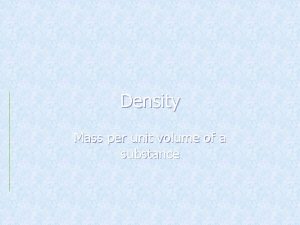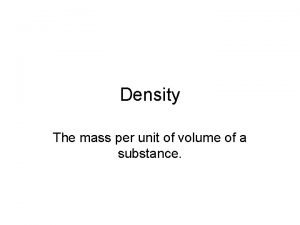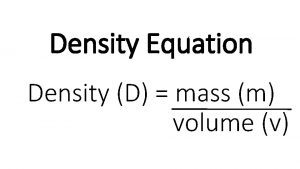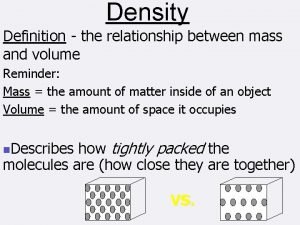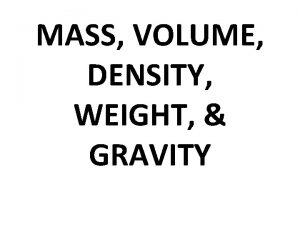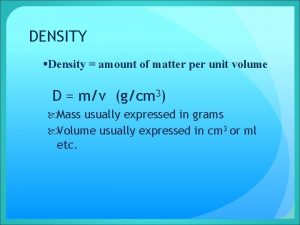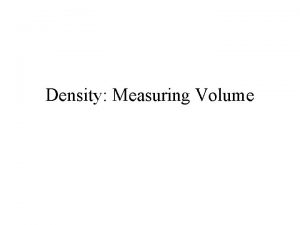Density The mass per unit of volume of














- Slides: 14

Density The mass per unit of volume of a substance.

The mass per unit of volume of a substance • Basically this means… How heavy something is compared to its size.

Tools to Measure Density • Measure mass of object using a balance. • Measure volume of object using a graduated cylinder. • Use calculator to divide mass by volume.

Density Formula • Density = mass divided by volume • Density = mass ÷ volume • D=m V

The metric units used when measuring density are … … a combination of the mass unit “g” and the volume unit “cm 3” or “m. L”. • If measuring the density of a solid the units are (g / cm 3) • If measuring the density of a liquid the units are (g / m. L)

In the metric system, the density of water is 1 g/m. L • Anything that floats in water has a density less than 1 g/m. L. (ie. 0. 2 g/cm 3) • Anything that sinks in water has a density more than 1 g/m. L. (ie. 2. 7 g/cm 3)

This is not by accident. When scientists created the Metric System they based it on water. They chose water for the following reasons: • Water is very common and is found everywhere people live on Earth. • Water is found in all three common states of matter (solid, liquid and gas) on the Earth’s surface. • Water is safe for humans to handle. It is not corrosive to skin or eyes.

What floats your boat? Density

Did you ever wonder how a boat that is made of steel can float? • Steel is a dense metal, how can it float?

A boat's average density is light compared to water's average density. • The standard definition of floating was first recorded by Archimedes and goes something like this: An object in a fluid experiences an upward force equal to the weight of the fluid displaced by the object. So if a boat weighs 1, 000 pounds (or kilograms), it will sink into the water until it has displaced 1, 000 pounds (or kilograms) of water. Provided that the boat displaces 1, 000 pounds of water before the whole thing is submerged, the boat floats.

A good portion of the interior of any boat is air. This increases the volume of the boat without increasing the mass by much.

If the air inside the boat is replaced by water the density of the boat will become more than 1 g/m. L and the boat will sink.

How about a submarine? Sometimes it sinks and sometimes it floats. • If it’s density is more than 1 g/m. L it submerges. • If it’s density is less than 1 g/m. L it floats toward the surface. • If it’s density is equal to 1 g/m. L it remains suspended in the water.

The average density of a boat -- the combination of the steel and the air -- is very light compared to the average density of water. So, very little of the boat actually has to submerge into the water before it has displaced the weight of the boat.
 Density mass per unit volume
Density mass per unit volume Mass per unit volume of a material
Mass per unit volume of a material The standard metric units of density are:
The standard metric units of density are: Volume * density = mass
Volume * density = mass How to get the volume
How to get the volume Density mass volume questions
Density mass volume questions How to find volume density and mass
How to find volume density and mass Mass equals density times volume
Mass equals density times volume What is density in chemistry
What is density in chemistry How to find mass with density and volume
How to find mass with density and volume Density triangle formula
Density triangle formula What is the relationship between mass volume and density
What is the relationship between mass volume and density What does a burette measure
What does a burette measure Mass, volume and density are all properties of
Mass, volume and density are all properties of Mass and volume to density
Mass and volume to density

